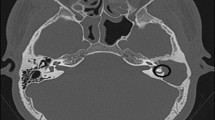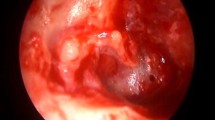Abstract
Thirty Patients of Unsafe chronic suppurative otitis media were subjected to pre-operative CT scanning followed by surgical exploration of the middle ear and mastoid, and their scans were compared with the peroperative data. High resolution CT scanning has been advocated for evaluation of unsafe chronic suppurative otitis media as it is capable of delineating detail required to detect Labyrinthine fistulae, Facial canal erosion, Sinus and Dural plate erosion and Ossicular integrity. Our results showed CT scan to be highly sensitive for soft tissue density mass in the middle ear and mastoid. Dural plate exposure, Sinus plate erosion, Facial canal and Stapes integrity, moderately sensitive for Malleus and Incus integrity and least sensitive for Lateral canal fistulae. Both Axial and Coronal scans were done as many important structures are best seen in only one of these planes. The principal merit of CT scan of the Tomporal bone lies in its inherent ability to depict pathology which is not clinically evident.
Similar content being viewed by others
References
Mafee, M. F., Levin, B. C., Applebaum, E. L., Campos, M. and james, C. F. (1988): Cholesteatoma of the middle ear and mastoid. A comparison of CT and operative findings. Otolaryngologic clinics of North America 24 (2) : 265–293.
O’Reilly, B. J., Chevretton, E. B., Wylie, I., Thakkar, C. Butler, P., Sathanathan, N. Morrison, G. A. and Kenyon G.S. (1991): The value of CT scanning in chronic suppurative otitis media. The journal of laryngology and otology 105 : 990–994.
Jackler, R. K., Dillon, W. P. and Schindler, R. A. (1984): Computed tomography in suppurative ear disease : A correlation of surgical and radiographic findings. Laryngoscope 94 : 746–752.
Bates, G.J., O’Donoghue, G. M., Anslow, P. and Moulding. T. (1988): Can CT detect labyrinthine fistulae preoperatively? Acta otolaryngologica 106: 40–45.
Johnson, D. W., Voorhees, R. L., Lufkin, R. B., Hanafee, W. and Canalis, R. (1983): Cholesteatomas of the temporal bone : Role of computed tomography. Radiology 148 : 733–737.
Phelps, P. D. and Wright, A. (1990): Imaging cholesteatoma. Clinical radiology. 41 : 156–162.
Sheehy, J. L., Brackmann, D. E., Graham, M. D. (1977): Complications of cholesteatomas : a report of 1024 cases. In First International conference on cholesteatoma (McCabe, B. F., Sade, J., Abramson, M. Eds), Aesculapius Press, Birmingham, Alabama. : 420–429.
Swartz, J. D. (1983): High resolution computed tomography of middle ear and mastoid. Radiology 148 : 449–454.
Author information
Authors and Affiliations
Rights and permissions
About this article
Cite this article
Berry, S., Gandotra, S.C. & Saxena, N.C. Role of computed tomography in unsafe chronic suppurative otitis media. IJO & HNS 50, 135–139 (1998). https://doi.org/10.1007/BF02991676
Issue Date:
DOI: https://doi.org/10.1007/BF02991676




